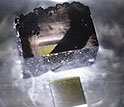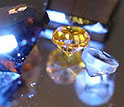News Release 05-080
New Technique Produces 10-carat Diamond
Crystal-clear material is better for optics, scientific applications

Five-carat diamond laser-cut from a 10-carat single crystal produced by high-growth rate CVD
May 16, 2005
This material is available primarily for archival purposes. Telephone numbers or other contact information may be out of date; please see current contact information at media contacts.
Researchers at the Carnegie Institution of Washington, D.C. have produced 10-carat, half-inch thick single-crystal diamonds at rapid growth rates (100 micrometers per hour) using a chemical vapor deposition (CVD) process. The size is approximately five times that of commercially available diamonds produced by the standard high-pressure/high-temperature (HPHT) method and other CVD techniques.
In addition, the team has made colorless single-crystal diamonds, transparent from the ultraviolet to infrared wavelengths with their CVD process.
Most HPHT synthetic diamond is yellow and most CVD diamond is brown, limiting their optical applications. Colorless diamonds are costly to produce and so far those reported are small. This limits general applications of these diamonds as gems, in optics, and in scientific research. Last year, the Carnegie researchers found that HPHT annealing enhances not only the optical properties of some CVD diamond, but also the hardness. Using new techniques, the Carnegie scientists have now produced transparent diamond using a CVD method without HPHT annealing.
"High-quality crystals more than three carats are very difficult to produce using the conventional approach," said scientist Russell Hemley, who leads the diamond effort at Carnegie. "Several groups have begun to grow diamond single crystals by CVD, but large, colorless, and flawless ones remain a challenge. Our fabrication of 10-carat, half-inch, CVD diamonds is a major breakthrough."
The results were reported at the 10th International Conference on New Diamond Science and Technology, Tsukuba, Japan, on May 12, 2005, and will be reported at the Applied Diamond Congress in Argonne, Ill., May 18, 2005.
"The rapid synthesis of large, single-crystal diamond is a remarkable scientific achievement, and has implications for a wide range of scientific and commercial applications," said David Lambert, program director in the National Science Foundation (NSF)'s earth sciences division, which funded the research.
To further increase the size of the crystals, the Carnegie researchers grew gem-quality diamonds sequentially on the six faces of a substrate diamond plate with the CVD process. By this method, three-dimensional growth of colorless single-crystal diamond in the inch-range is achievable.
Finally, new shapes have been fabricated with the blocks of the CVD single crystals.
The standard growth rate is 100 micrometers per hour for the Carnegie process, but growth rates in excess of 300 micrometers per hour have been reached, and 1 millimeter per hour may be possible. With the colorless diamond produced at ever higher growth rate and low cost, large blocks of diamond should be available for a variety of applications.
"The diamond age is upon us," said Hemley.
-NSF-
-
Single-crystal diamond block formed by CVD process
Credit and Larger Version -
The CVD process can produce a variety of single crystal diamonds.
Credit and Larger Version
Media Contacts
Cheryl L. Dybas, NSF, (703) 292-7734, email: cdybas@nsf.gov
The U.S. National Science Foundation propels the nation forward by advancing fundamental research in all fields of science and engineering. NSF supports research and people by providing facilities, instruments and funding to support their ingenuity and sustain the U.S. as a global leader in research and innovation. With a fiscal year 2023 budget of $9.5 billion, NSF funds reach all 50 states through grants to nearly 2,000 colleges, universities and institutions. Each year, NSF receives more than 40,000 competitive proposals and makes about 11,000 new awards. Those awards include support for cooperative research with industry, Arctic and Antarctic research and operations, and U.S. participation in international scientific efforts.
Connect with us online
NSF website: nsf.gov
NSF News: nsf.gov/news
For News Media: nsf.gov/news/newsroom
Statistics: nsf.gov/statistics/
Awards database: nsf.gov/awardsearch/
Follow us on social
Twitter: twitter.com/NSF
Facebook: facebook.com/US.NSF
Instagram: instagram.com/nsfgov




